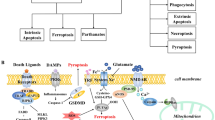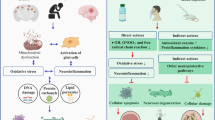Abstract
Curcumin, a member of the curcuminoid family of compounds, is a yellow colored phenolic pigment obtained from the powdered rhizome of C. longa Linn. Recent studies have demonstrated that curcumin has protective effects against cerebral ischemia/reperfusion injury. However, little is known about its mechanism. In the present study, we tested the effects of curcumin in focal cerebral ischemia in rats and the possible mechanisms. Adult male Sprague–Dawley rats were treated with curcumin (100, 300 and 500 mg/kg) administered intraperitoneally after 60 min of occlusion (beginning of reperfusion). Neurological score and infarct volume were assessed at 24 and 72 h. Oxidative stress was evaluated by malondialdehyde assay and the apoptotic mechanisms were studied by Western blotting. Curcumin treatment significantly reduced infarct volume and improved neurological scores at different time points compared with the vehicle-treated group. Curcumin treatment decreased malondialdehyde levels, cytochrome c, and cleaved caspase 3 expression and increased mitochondrial Bcl-2 expression. Inhibition of oxidative stress with curcumin treatment improves outcomes after focal cerebral ischemia. This neuroprotective effect is likely exerted by antiapoptotic mechanisms.




Similar content being viewed by others
References
Ghoneim AI, Abdel-Naim AB, Khalifa AE et al (2002) Protective effects of curcumin against ischaemia/reperfusion insult in rat forebrain. Pharmacol Res 46:273–279
Thiyagarajan M, Sharma SS (2004) Neuprotective effect of curcumin in middle cerebral artery occlusion induced focal cerebral ischemia in rats. Life Sci 74:969–985
Wang Q, Sun AY, Simonyi A et al (2005) Neuroprotective mechanisms of curcumin against cerebral ischemia-induced neuronal apoptosis and behavioral deficits. J Neurosci Res 82:138–148
Zhao J, Zhao Y, Zheng WP et al (2008) Neuroprotective effect of curcumin on transient focal cerebral ischemia in rats. Brain Res 1229:224–232
Mattson MP, Duan W, Pedersen WA (2001) Neurodegenerative disorders and ischemic brain diseases. Apoptosis 6:69–81
Kowaltowski AJ, Castilho RF, Vercesi AE (2001) Mitochondrial permeability transition and oxidative stress. FEBS Lett 495:12–15
Kroemer G (2003) Mitochondrial control of apoptosis: an introduction. Biochem Biophys Res Commun 304:433–435
Lim ML, Lum MG, Hansen TM (2002) On the release of cytochrome c from mitochondria during cell death signaling. J Biomed Sci 9:488–506
Kuwana T, Mackey MR, Perkins G (2002) Bid, Bax, and lipids cooperate to form supramolecular openings in the outer mitochondrial membrane. Cell 111:331–342
Li P, Nijhawan D, Budihardio I (1997) Cytochrome c and dATP-dependent formation of Apaf-1/caspase-9 complex initiates an apoptotic protease cascade. Cell 91:479–489
Green DR, Reed JC (1998) Mitochondria and apoptosis. Science 281:1309–1312
Li Y, Chopp M, Jiang N (1995) Temporal profile of in situ DNA fragmentation after transient middle cerebral artery occlusion in the rat. J Cereb Blood Flow Metab 15:389–397
Dutta S, Padhye S, Priyadarsini KI et al (2005) Antioxidant and antiproliferative activity of curcumin semicarbazone. Bioorg Med Chem Lett 15:2738–2744
Lim CS, Jin DQ, Mok H et al (2005) Antioxidant and antiinflammatory activities of xanthorrhizol in hippocampal neurons and primary cultured microglia. J Neurosci Res 82:831–838
Singh S, Khar A (2006) Biological effects of curcumin and its role in cancer chemoprevention and therapy. Anticancer Agents Med Chem 6:259–270
Longa EZ, Weinstein PR, Carlson S (1989) Reversible middle cerebral artery occlusion without craniectomy in rats. Stroke 20:84–91
Tsubokawa T, Solaroglu I, Yatsushige H et al (2006) Cathepsin and calpain inhibitor E64d attenuates matrix metalloproteinase-9 activity after focal cerebral ischemia in rats. Stroke 37:1888–1894
Wei X, Liu H, Sun X (2005) Hydroxysafflor yellow A protects rat brains against ischemia-reperfusion injury by antioxidant action. Neurosci Lett 386:58–62
Calvert JW, Zhou C, Nanda A et al (2003) Effect of hyperbaric oxygen on apoptosis in neonatal hypoxia-ischemia rat model. J Appl Physiol 95:2072–2080
Chan PH (1996) Role of oxidants in ischemic brain damage. Stroke 27:1124–1129
Acknowledgments
This work was supported by grants from the Science and Technology Foundation of Chongqing Medical University, China (XBYB2007089).
Author information
Authors and Affiliations
Corresponding author
Rights and permissions
About this article
Cite this article
Zhao, J., Yu, S., Zheng, W. et al. Curcumin Improves Outcomes and Attenuates Focal Cerebral Ischemic Injury via Antiapoptotic Mechanisms in Rats. Neurochem Res 35, 374–379 (2010). https://doi.org/10.1007/s11064-009-0065-y
Accepted:
Published:
Issue Date:
DOI: https://doi.org/10.1007/s11064-009-0065-y




